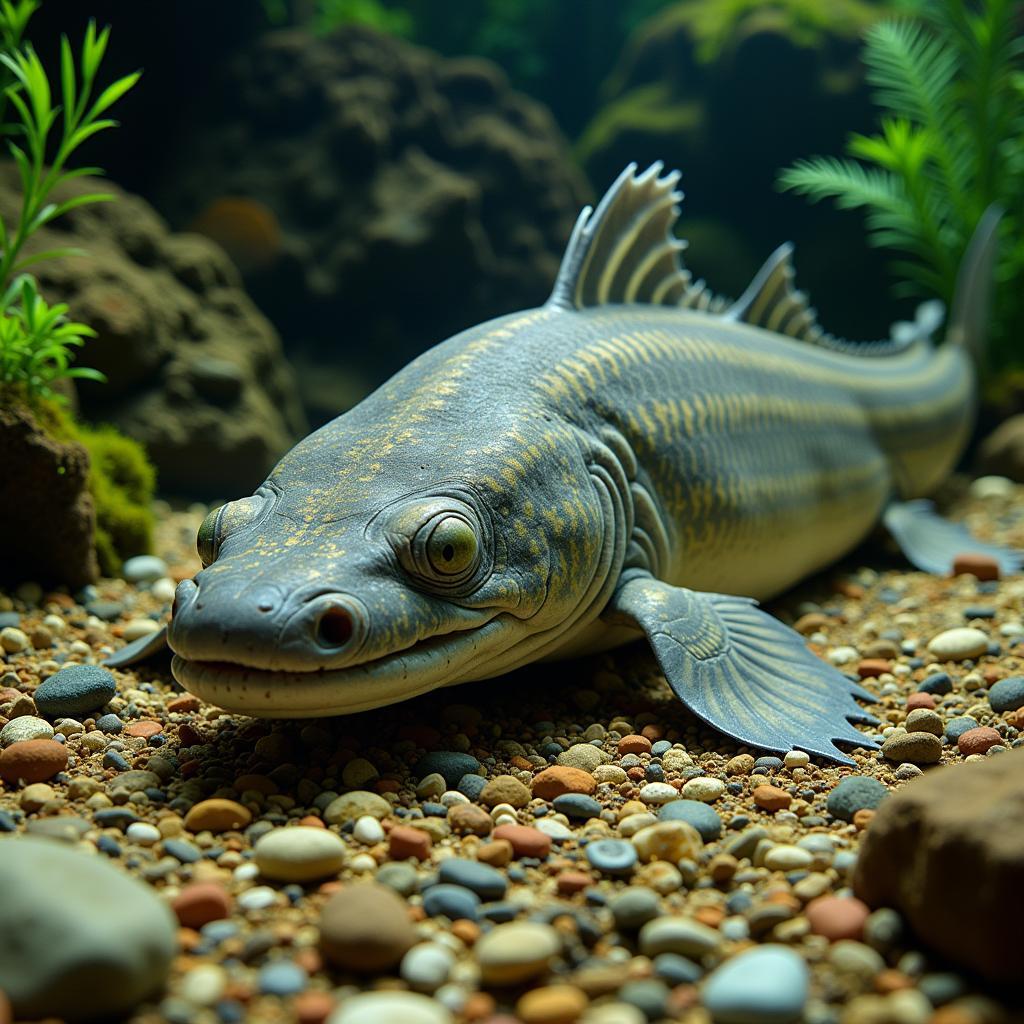Sturgeon Fish Food plays a crucial role in the health, growth, and overall well-being of these ancient and fascinating creatures. Whether you’re a seasoned aquarist or just starting out with sturgeon, understanding their dietary needs is essential for their long-term success in your care. This comprehensive guide will delve into the intricacies of sturgeon fish food, covering everything from their natural diet in the wild to the best commercially available options.
Understanding Sturgeon Feeding Habits
Sturgeons are benthic feeders, meaning they primarily forage for food at the bottom of rivers and lakes. Equipped with sensitive barbels around their mouths, they detect prey through touch and taste rather than relying on their eyesight. In their natural habitat, sturgeon fish consume a diet consisting mainly of:
-
Insects and Larvae: A significant portion of a wild sturgeon’s diet comprises aquatic insects and their larvae, which are rich in protein and essential nutrients.
-
Crustaceans: Crayfish, shrimp, and other small crustaceans provide valuable sources of protein, calcium, and other minerals.
-
Mollusks: Sturgeons use their powerful jaws and bony plates to crush and consume mollusks like snails and clams, which offer a good source of energy and minerals.
-
Small Fish: While not their primary food source, sturgeons may opportunistically consume small fish, particularly as they grow larger.
 Sturgeon Feeding in the Wild
Sturgeon Feeding in the Wild
Choosing the Right Sturgeon Fish Food
Replicating a sturgeon’s natural diet in captivity is crucial for their health and longevity. Here’s what to look for when selecting sturgeon fish food:
1. High-Quality Protein:
Protein is essential for muscle development, growth, and overall health in sturgeon. Look for pond fish food pellets with a protein content of at least 40%, derived from high-quality sources like fish meal, krill meal, or insect protein.
2. Essential Fatty Acids:
Omega-3 and omega-6 fatty acids are vital for immune function, cell growth, and overall vitality. Fish oil, krill oil, and algae meal are excellent sources of these essential fatty acids.
3. Sinking Pellets:
As bottom feeders, sturgeons require sinking pellets that reach the bottom of the tank or pond where they naturally forage. Floating pellets will remain uneaten and can contribute to water quality issues.
4. Appropriate Pellet Size:
Choose a pellet size appropriate for the size of your sturgeon. Smaller sturgeon will need smaller pellets, while larger specimens can handle larger sizes.
5. Vitamin and Mineral Content:
Just like any other fish, sturgeons need a balanced intake of vitamins and minerals for optimal health. Look for sturgeon food fortified with essential vitamins like A, D, E, and K, as well as minerals like calcium, phosphorus, and magnesium.
Feeding Frequency and Quantity
The amount and frequency of feeding will depend on the age, size, and activity level of your sturgeon.
- Young Sturgeon: Feed young sturgeons 2-3 times daily, offering an amount they can consume within a few minutes.
- Adult Sturgeon: Once your sturgeon reaches adulthood, you can reduce feeding to once or twice daily.
- Water Temperature: Sturgeons are cold-water fish, and their metabolism slows down in colder temperatures. Adjust feeding frequency accordingly, feeding less often in cooler water.
Overfeeding can lead to water quality problems, so it’s crucial to avoid giving them more than they can eat in a single feeding.
Supplements and Treats
While a high-quality sturgeon fish food should provide the majority of their nutritional needs, you can occasionally offer treats and supplements to enrich their diet:
- Live or Frozen Foods: Treat your sturgeon to occasional live or frozen foods like bloodworms, brine shrimp, or chopped earthworms.
- Vegetables: Blanched peas, zucchini, and spinach can provide additional vitamins and fiber.
- Vitamin Supplements: Consult with a veterinarian or aquatic animal specialist to determine if your sturgeon would benefit from additional vitamin or mineral supplements.
Sturgeon Fish Food: FAQs
How do I know if I’m feeding my sturgeon enough?
Observe their feeding behavior. If they eagerly consume all the food within a few minutes and appear active and healthy, you’re likely feeding them the right amount. If food is left uneaten or they seem lethargic, adjust the quantity accordingly.
Can I feed my sturgeon goldfish?
While sturgeons may eat small goldfish in the wild, it’s best to avoid feeding them as a staple diet in captivity. Goldfish can carry parasites and diseases that can be harmful to sturgeon.
What should I do if my sturgeon refuses to eat?
A loss of appetite can be a sign of stress, illness, or improper water parameters. Check the water quality, ensure the water temperature is appropriate, and observe your sturgeon for any signs of disease. If the issue persists, consult with a veterinarian or aquatic animal specialist.
Conclusion
Providing your sturgeon with the right diet is fundamental to their health and well-being. By understanding their natural feeding habits and selecting a high-quality sturgeon fish food, you can ensure these captivating creatures thrive in your care. Remember to observe their feeding behavior, adjust the quantity and frequency as needed, and consult with experts if you have any concerns. With proper care and nutrition, your sturgeon can live a long and healthy life in your aquarium or pond.
If you need help selecting the best sturgeon fish food or have any other questions about sturgeon care, don’t hesitate to contact us. Our team at Mina Cones Food is here to assist you:
Phone: 02437655121
Email: [email protected]
Address: 3PGH+8R9, ĐT70A, thôn Trung, Bắc Từ Liêm, Hà Nội, Việt Nam.
We offer 24/7 customer support and a wide selection of high-quality caviar cream food and gourmet food caviar to meet all your sturgeon’s nutritional needs.